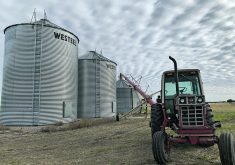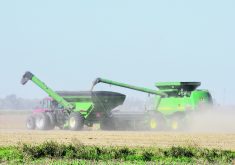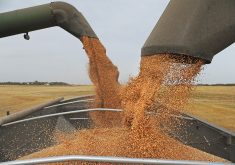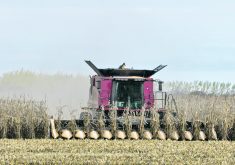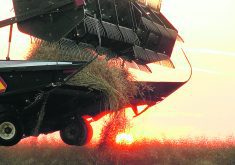MANITOBA
SOUTHWEST
High winds damaged crops last week. Isolated showers also hit, helping some areas and hindering others.
Heat and dryness have allowed wet crops to rush forward in a race with weeds. Winds have slowed weed spraying.
Early cereals are heading and late crops are in flag leaf. Fungicide applications are being done. Early canola is bolting while later crops are vegetating outward. Flea beetle and cutworm damage has been noticed.
Saturation problems are fading, but some damage has been done in low areas.
Read Also

Canadian Food Inspection Agency red tape changes a first step: agriculture
Farm groups say they’re happy to see action on Canada’s federal regulatory red tape, but there’s still a lot of streamlining left to be done
First cut of hay is being made. Pastures are lush.
NORTHWEST
Wild weather buffeted crops, including extreme winds, hail and rain, but generally warm and dry conditions allowed soaked crops to advance.
The flood risk on rivers and streams is fading.
Some farmers are reseeding because of soil saturation. There are many yellowed crops in heavy soil areas.
Early cereals are starting to head. Early canola has started flowering and peas have begun blooming.
Fungicide applications and weed spraying are widespread, often by planes.
Hay crops are good, but haying is not general.
CENTRAL
Warm and dry weather allowed crops to advance quickly after being stalled by wet weather. Strong winds damaged some crops.
Farmers are racing to control weeds and diseases. Cereals are heading or going into heading. Canola is in many development stages and most are affected by saturation. Continued dryness and warmth are needed.
Corn is shorter than normal because of coolness and saturation but is recovering lost ground. Soybeans show damage from saturation and need continued good weather to recover.
Much hay has been cut and looks good. Alfalfa weevil is evident.
Pastures are good, as are dugouts.
EASTERN
Warm weather is helping to advance crops, although high winds caused damage.
Winter crops are filling.
Early cereals are heading and some are flowering. Most canola has begun flowering. Farmers are spraying for disease and weeds. Most crops look good.
Corn is advancing well now that there is some heat and sun.
Good hay is being cut. Most pastures are good except in a dry southern patch.
INTERLAKE
Tempestuous weather dumped heavy rain on some fields but left others to dry out. Many crops damaged from earlier saturation.
Crops need warm, dry weather to recover.
Crop stages are varied, but early cereals are heading and canola is flowering. Much spraying is occurring.
Hay is OK and pastures are improving.
Saskatchewan
Saskatchewan producers have seeded 98 percent of this year’s crop, outpacing the five-year average and well ahead of last year when 82 percent was seeded.
Most of the province saw some rain last week, as much as 100 millimetres in some areas, leaving producers with wet soil conditions, which has delayed development of some crops. Those that have emerged are in good to fair condition.
Southern
Seeding is largely complete, but rainfall in the southeast has delayed pest control applications.
Topsoil moisture in the region is rated as 39 percent surplus and 61 percent adequate. In some areas, where excess water has caused localized flooding, reseeding attempts have stopped.
Hail damage has been reported to canola crops in the region, while other emerged crops are stressed and diseased from cooler temperatures and excess moisture. Winter wheat crops have headed out and may be sprayed for fusarium.
In the southwest, cropland moisture is rated as 30 percent surplus and 70 percent adequate. While moisture has delayed some spraying, producers are expected to be back in the field over the next week.
Central
Producers in west-centralSaskatchewan are slightly ahead of their east-central counterparts, who have 96 percent of the crop seeded.
Farmers in that area saw large amounts of rain last week and some are dealing with severe flooding in low-lying areas. Spraying attempts have been delayed, while weeds are quickly advancing. Cropland topsoil moisture is rated as 58 percent surplus and 42 percent adequate.
A severe thunderstorm damaged many crops in west-central Saskatchewan, where topsoil moisture is 62 percent surplus and 38 percent adequate. The rain and cooler weather have delayed crop development.
North
Almost all of the crop has been seeded across northern Saskatchewan, while topsoil moisture for cropland varies from 14 percent surplus in the northwest to 70 percent surplus in the northeast, where crop conditions are deteriorating.
Some canola is said to be yellowing and may not recover without warmer weather. There’s also evidence of damage from cutworms and gophers.
There are reports of localized flooding in the northwest, where rain and hail have damaged fields and excess moisture has yellowed crops.
Pest control in that region is progressing and some canola crops will require a second herbicide application soon.
ALBERTA
SOUTH
More than 200 millimetres of rain have fallen in the Lethbridge region between April 1 and June 27. Normal levels for that period are 140 mm.
Hail was reported mid-week in the counties of Warner, Taber and Forty Mile. The swath was about two kilometres wide, and in some instances golf ball to pool ball sized hail wiped out crops in its path. It is too late for some of them to recover.
Outside the hail zone, cereals and specialty crops of sugar beets, corn and potatoes look good but need consistent heat of 25 to 30 C.
Cabbage seedpod weevils are above threshold levels so scouting is recommended.
Some stripe rust has been seen in the Rolling Hills area but doesn’t seem to be spreading.
Fusarium is expected to be an issue and some preventive spraying is likely now that crops are beginning to head out.
Cabbage seedpod weevils have been reported in the Vulcan area. Alfalfa weevil is reported in many alfalfa crops in the Lethbridge region.
There is a risk of sclerotinia in canola, but producers should use the Alberta Agriculture checklist, which is available online, when making spraying decisions.
CENTRAL
Hail in a few pockets of the east-central regions beat down crops but many are recovering well. A long, warm fall is needed to make sure these crops can mature before frost.
Record levels of rain bring leaf diseases, so spraying has started.
Some reports of diamondback moths are coming from the Stettler region. The moth appeared to overwinter, which is unusual. No issues with grasshoppers, flea beetles or cutworms.
Crops look good for this time of year and farmers are optimistic, but heat is needed to encourage growth.
NORTHEAST
Crop and pasture conditions are good overall, although a timely rain would be appreciated. No outbreaks of insects have been reported. Weeds are under control, but spraying is underway for cereal leaf diseases.
NORTHWEST
Favourable moisture conditions have encouraged good crop growth across the region.
There are no insect problems to report, but grasshopper sweeps will start in the next week.
No plant diseases have been reported so normal treatments will be used.
Hay is growing tall and cutting will start shortly. Pastures are good. Dugouts are normal to above normal capacity.
PEACE
Late seeding because of heavy spring rain has delayed crops, but conditions are improving in northern reaches of the district. Spraying has started for tent caterpillars, and some cutworms have been spotted. Hay conditions are good to excellent, and cutting should begin within the week.
Further south in the district, field scouting for grasshoppers, wire worms and cutworms is underway. Grasshopper infestations were high last fall so crop specialists are monitoring for an outbreak as the weather starts to warm. Ecobran will be spread for control.
Crops are about a week behind.



